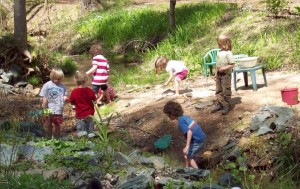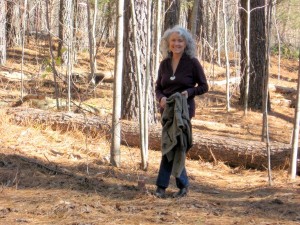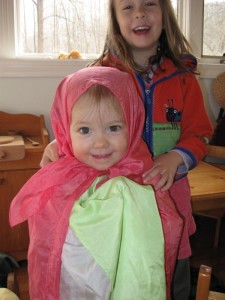Our family is the container, the safe space in which young souls are cultivated. They grow in this atmosphere, with the mixture of necessary elements. When they know themselves well enough, they step outside the family, into the strong wind of their own life.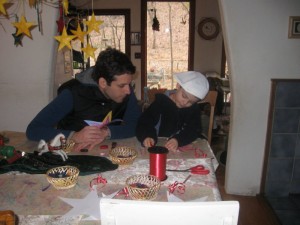
I believe there is one central task that each parent is given with the birth of his or her child. This is to carry for the child, until he can carry for himself, the fundamental human question, “Who am I?” When we look into our beloved child’s face, we can look down the long corridor of his life, inquiring who the man will be. As parents, we certainly will see particular characteristics, tendencies, in our child. We will offer much love and effort in guiding these inclinations in the right direction. But this work must be done in secret, veiled from the child. Our goal is to have the young adult step into this “self-making” with freedom. We foster freedom by holding open the question, “Who are you?” The container of the family is the vessel in which we carry this question
Warm weather is coming
These last few warm days make us ache for the wide expanse of summer, when everything is done outdoors! The children are tumbling through their mornings like spring lambs, the bulbs we planted at our Harvest Festival are poking green heads up through the brown earth, and the first crocuses opened their golden crowns into the light!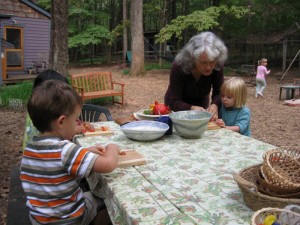
Movement and Brain Function
Movement and brain function: did you know that when we rock side to side, this movement stimulates the relaxation centers of the brain? And when we rock forward and backward, the focus and intention centers are activated? So, when the parent sits and rocks the baby in a rocker, the baby is relaxed and the parent is focused…..amazing grace!
Circle Time is Great Fun and Great Brain Development, too.
I spent a good amount of time over the Winter Break studying the latest brain-development research. All of the research I worked with supports The Rose Garden’s basic philosophy: plenty of outdoor time, a wide palette of sensory experience, the individual exploration of creative play and lots of artistic activities and stories. Perhaps most important, though, is the research that correlates the necessity of both fine and large motor movement with an intimate connection to sound and music.
I have an idea that I hope to pursue: I’d love to write a piece that describes detail by detail a typical day at The Rose Garden. Woven through this I will describe the research that explains the WHY of all the large and small experiences offered the children. This will take a while to accomplish! Meantime, here is a short video of today’s Circle Time and snack clean up for you to enjoy….joyful movement amidst a tapestry of language and song. Just what the Doctor orders!
Ooops…let me work on posting the video!
Let’s Talk About Play!
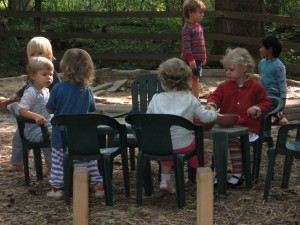 The Rose Garden has a Parent Evening coming up on Jan 27th, and we will be talking about the necessity of children’s play. Join us, if you can, or drop me a note with your thoughts! Here is an excerpt from Heaven on Earth
The Rose Garden has a Parent Evening coming up on Jan 27th, and we will be talking about the necessity of children’s play. Join us, if you can, or drop me a note with your thoughts! Here is an excerpt from Heaven on Earth
We say that children “learn by doing.” This is a common way of saying that the learning process is a miraculous orchestration and integration of the entire body, moving a million tiny interconnected particles toward the “gestalt” that is meaning. Children think through movement and play. In movement and play the brain goes through all the complex processes of growth and learning. The main avenue through which the child perceives the world is the realm of the senses. Through the natural sensory input of play, the child actively makes the world his own, rather than remaining a passive observer. Neurophysiologist Carla Hannaford, author of Smart Moves, says, “The richer our sensory environment, and the greater our freedom to explore it, the more intricate will be the patterns for learning, thought and creativity. . . . Our sensory experiences, both external and internal, shape our way of imaging and therefore, our thinking.” It is the life force through which the young child plays that will grow eventually into cognitive thought.
If we watch a young child at play, we can see that through her constant sensory/physical interaction with the environment, she gains experience and understanding of the situation, of herself, and the relationship between the two. She comes to know herself, the world, and what flows between.
Through sensory-rich play, the child gains a certain mastery over her body, and her world. She also begins to understand the inner world of emotional experience. It is critical that, through play, the different areas of the brain that control thought and emotion begin to communicate. “The frontal lobe,” Hannaford writes, “is able to synthesize thought with emotion through . . . the limbic system to give us compassion, reverence for life, unconditional love and all-important play.”
Circles Games, Cycles of Life
Our children, and indeed children everywhere, break into spontaneous circle games. Their small bodies, psyches, and souls reflect great cosmic circles. 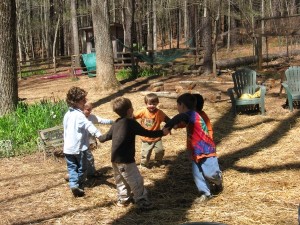 In our childrens’ joyous, dizzying games we can see intimations of the whirling bodies, vapors and colors sent back to us from Hubble’s photographs. Soon we will pass through one of these nodal points, the Winter Solstice, and Light will be born again. Not only in Springtime, but now deep in the winter, new beginnings stir.
In our childrens’ joyous, dizzying games we can see intimations of the whirling bodies, vapors and colors sent back to us from Hubble’s photographs. Soon we will pass through one of these nodal points, the Winter Solstice, and Light will be born again. Not only in Springtime, but now deep in the winter, new beginnings stir.
Perhaps your family has managed to escape the crush of commercialism, and you are preparing for a simple and cherished holiday time together. It is at these festival gatherings that we have the opportunity to “step outside of time” to review the year we have just completed, as well as envision the year to come. Take a moment at the holiday meal, to recollect together high points of your year, and also look together toward the growth the coming year will bring. As we engage in this recounting of our family’s story, and creatively imagining our future, we build up an oral history. This Living Book of Life will nourish our children, as well as model for them how we create, through images, the life we want to live.
Our year here at The Rose Garden has been full. Family Camp was magical last summer, and our circle of friends has widened. The garden has grown and the children have too. Some of them have stepped into new adventures in Grade School, and have returned to visit us, shining with new capacities and knowledge. New families have joined us, and new friendships bloom. New Land has graced us!
Looking toward the future, here is an idea I want to share with you. Let’s use this blog as one forum for your parenting questions. (Check the Family Consultation page for other ways to address your questions, too.) It seems the downturn in the economy has brought into vogue the parenting values we have always held dear. Now you read about “free-range parenting”, or “slow parenting”. The Rose Garden’s description has always been “A Slow Meander Through Early Childhood.” Email me your questions, observations, thoughts, concerns, and I will be happy to share ideas with you. Your questions, most certainly, are mirrored in many other parents, and we can look at these together. Together we can explore the particulars of your own child’s slow meander.
My holiday wish for you and your family is that you go along slowly, enjoy one another, and spend plenty of time playing together outdoors! Let me know your thoughts and questions! Sharifa
Family Camp is Coming
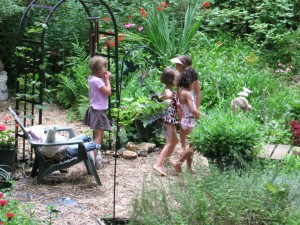 It is summer in Virginia. The earth is made soft by a million autumns laying down carpets of gold, crumbled into black humus. Morning mist rises from the creek-bed. The wood thrush announces joy. The ruby-throated hummingbird peers in my kitchen window before she sips and veers away. Afternoon cicadas tune up for the evening performance. Human children join this forest community. They are just as tender and vulnerable, just as bursting with life force as their brothers and sisters, the furred, feathered and finned ones with whom they play, side-by-side. Each one of them needs our love and protection; we need their fresh hope.
It is summer in Virginia. The earth is made soft by a million autumns laying down carpets of gold, crumbled into black humus. Morning mist rises from the creek-bed. The wood thrush announces joy. The ruby-throated hummingbird peers in my kitchen window before she sips and veers away. Afternoon cicadas tune up for the evening performance. Human children join this forest community. They are just as tender and vulnerable, just as bursting with life force as their brothers and sisters, the furred, feathered and finned ones with whom they play, side-by-side. Each one of them needs our love and protection; we need their fresh hope.
Love, protection, freshness, hope. All of this is alive for the children, as they play barefoot in the garden, splash free in the creek. Days slip by in a primordial “here-ness, now-ness” Growth, exploration, new neural pathways, friendship, home-made meals, all are contained in the over-arching Presence of the living forest.
Soon, we will be joined by families coming from as far away as San Francisco and Florida, as well as those coming from a few miles down the road. For five days we will put our lives together, alongside the lives of the woodland creatures, and together we will all know something new!
In The Garden, Again!
Today the children, Rebecca and I returned to the garden playground! Last autumn, after the Harvest Festival, the children and their parents came to school for a Saturday picnic, to “put the garden to bed”. We raked out the leaves, took the scarecrow apart, and spread her straw into the beds for winter mulch, pulled out the old stalks, and laid everything to rest for the winter. Through the very long and cold winter, from time to time, a child would ask, “but when do we get to go back to the garden?” Today was the day, and everyone was thrilled! The five year olds were discussing the exact place they had left off playing their “garden games” and the little ones were trying to remember which path we take to get to the garden.
Our garden is a little bright spot in the deep Virginia woods. It is laid out in the curve of our stream, and we must walk across a small footbridge to get there. The children love to play “in the garden” because this includes splashing in the shallow water of the stream, looking for salamanders, water skaters, cray fish and all their relations. As well as the endless back and forth across the little bridge, to play on the swing set, in the sandbox , under the scented branches of the butterfly bush, nibbling herbs and flowers as they go.
It is such a gift to teach these young souls, here in the generous arms of Nature. The children develop intimate relations with the insect and animal world, from the army of worms they unearth (and re-earth!) to the song of the wood-thrush they hear and the footprints of the raccoon in the mud beside the creek.
The native people pray by intoning “All My Relations.” And the children talk of the great family of Nature: our best friends the Rain Fairies, their mother The Great Mother Rain Cloud, Brother Wind, Father Sun. These children have the foundation laid for a life lived experiencing humanity as part of a great seamless Whole. This is preparation for the only future we can sustain. This is our one hope, and they bring their up- springing joy to it!
Miracle of the Mixed Age Group
It is so unusual at this time in our society to see young children in a wide spread of ages, mixed together in an early childhood program. Because young children change at such a rapid pace, it is easy to imagine that their changing needs will be better met if we separate them out, and “teach” to the specific developmental age. But I find quite the opposite is true. When we mix the ages, the “teaching” happens in an organic fashion, the way it has for millennia.
Children develop on a continuum, new growth is built upon that which is familiar, as well as through imitation of the “new” which is modeled. Children follow a predictable developmental pattern. When we allow the children to be grouped in the traditional way, in mixed ages, we strengthen the learning of both the younger children and that of the older children as well.
It is clear and obvious the tremendous advantage the younger child has in this situation, in that they can through imitation learn new language patterns, new social skills can be developed, new imaginative abilities are discovered and so forth. What is less obvious is the tremendous advantage a mixed age group offers to the older children.

